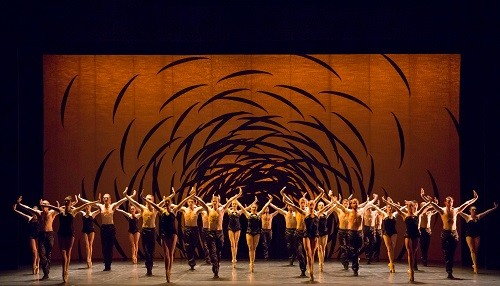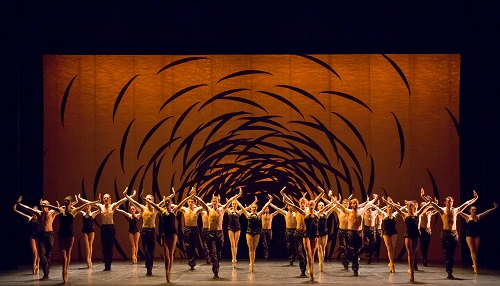 United Kingdom Webb, Laplane, Pite: Scottish Ballet, Theatre Royal, Glasgow, 1.10.2016. (SRT)
United Kingdom Webb, Laplane, Pite: Scottish Ballet, Theatre Royal, Glasgow, 1.10.2016. (SRT)

Drawn to Drone
Choreography – Jack Webb
Sibilo
Choreography – Sophie Laplane
Music – Alex Menzies
Lighting – George Thomson
Emergence
Choreography – Crystal Pite
Music – Owen Belton
Costumes – Linda Chow
Lighting – Alan Brodie
Set – Jay Gower Taylor
Addressing the audience before this evening’s show began, Christopher Hampson, Scottish Ballet’s Artistic Director, described Canadian choreographer Crystal Pite as one of the hottest choreographers on the planet. She currently has a piece at the Paris Opéra, and the Royal Ballet showcase a new work of hers later this season. Emergence, however, is her first work in the UK, and Scottish Ballet are rightly proud to have secured it. It’s a real coup for them and, after they premiered it in this year’s Edinburgh International Festival, I caught up with it at the end of the company’s Glasgow run.
Pite created the piece after working with the National Ballet of Canada in 2009. She had worked with smaller dance companies before, but this was her first time with a larger ensemble, and the hierarchical structure fascinated her. She then began to look around for parallels which would allow her to portray and explore the idea of hierarchy on the stage, and she found inspiration in the natural world, with its hives of bees, flocks of starlings or schools of fish. Emergence is the result.
It’s the insect analogy that you sense first of all, with the dancers emerging onto the stage scuttling through a tunnel, like ants in an anthill, against a dazzling backdrop of flickering lights. The movements are spiky, edgy, spindly, with jagged angles and crooked limbs that repeatedly made me think of a spider’s legs, and the dancers’ centre of gravity tends to be in the shoulders and elbows, creating a slightly top-heavy appearance that’s exciting to watch. The movements are razor-sharp, however, and the unanimity of the company’s ensemble is virtuosic.
Something darker lurks in the heart of the work, though. Far from simply recreating an insect colony, Pite explores the psychology of the collective against the individual, and the results are often unsettling. Jackboots ring out towards the beginning, with the male dancers bent over, as though oppressed, facelessly enacting the moves without engaging with either the audience or one another. At one point, the line of ladies sweeps a small group of men off the stage. One resists, but is unable to break the force against him. Furthermore, Owen Belton’s soundtrack sometimes gets the dancers to reinforce the stage movements through counting out loud, something which could be used only for technical reasons but which here sounds menacing, almost threatening. The final ensemble (pictured) is thrilling to watch, but I couldn’t shake a slight feeling of dread in it, as though individuality had been squashed and that the victory of the collective wasn’t necessarily healthy.
There’s also something of the hive in Sophie Laplane’s Sibilo, where one of the eight dancers’ actions tends to affect all the others. Laplane is a choreographer drawn from within the company, and she created this piece for dancers that she knows well. Sibilo comes from the Latin verb to whistle, and the whistling theme runs through the piece. It appealed to Laplane as a form of music that almost everyone can do, and some jaunty, upbeat bits of whistling music alternate with the electronic score of Alex Menzies. That controls the mood of the dancing: the whistling tends to go with something upbeat or comic, like the duet who mime throwing a ball to one another, while the electronica leads to dancing that is darker and more searching, nowhere finer than in the duet for two men who share one jacket, their bodies melding into one another’s forms, creating a series of spellbinding images.
We also got a brief, extra, unadvertised treat from Christopher Harrison, dancing Jack Webb’s Drawn to Drone. It’s a short, trance-like, piece for one dancer balancing on a couple of chairs, very slowly extending and unfolding his limbs, almost like yoga, but doing so with perfect symmetry and against hypnotic music that underscores the feeling of a ritual. Harrison was stripped down to a pair of white briefs, and the slowness of the movements suggested both he and Webb revelling in the beauty and poetry of his own form.
After a lacklustre Swan Lake at the end of last season, this set showcases Scottish Ballet in a triumphant return to form. It now goes on tour to Inverness and Aberdeen until 15 October. It’s well worth seeking out.
Simon Thompson
